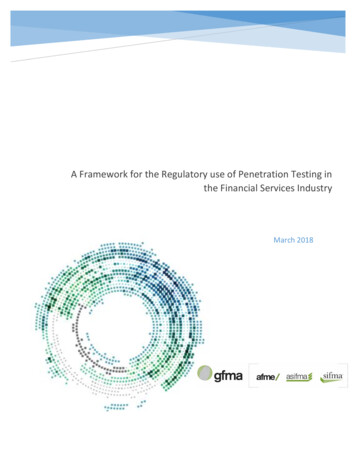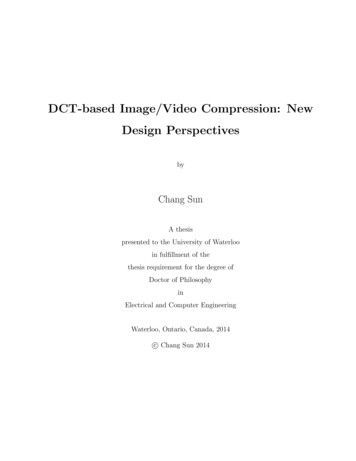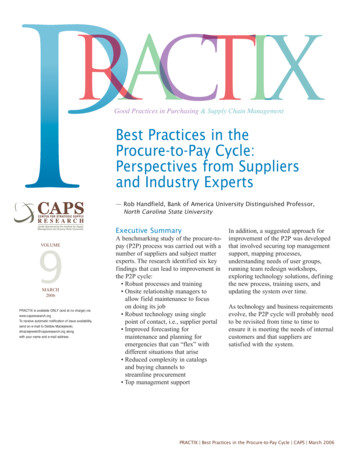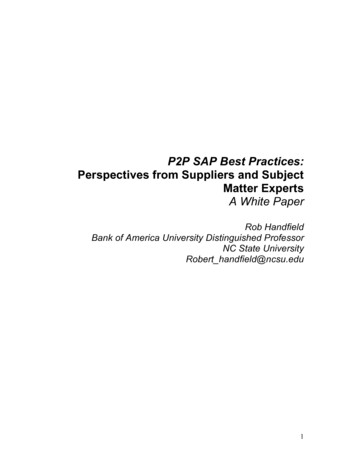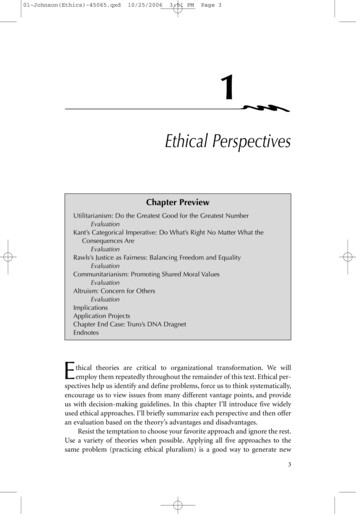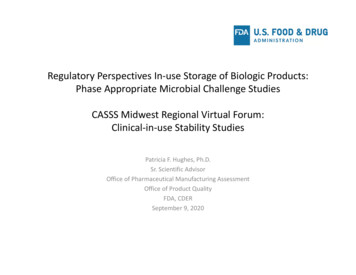
Transcription
Regulatory Perspectives In‐use Storage of Biologic Products:Phase Appropriate Microbial Challenge StudiesCASSS Midwest Regional Virtual Forum:Clinical‐in‐use Stability StudiesPatricia F. Hughes, Ph.D.Sr. Scientific AdvisorOffice of Pharmaceutical Manufacturing AssessmentOffice of Product QualityFDA, CDERSeptember 9, 2020
Pharmaceutical QualityA quality product of any kind consistentlymeets the expectations of the user.www.fda.gov2
Pharmaceutical QualityA quality product of any kind consistentlymeets the expectations of the user.Drugs are no different.www.fda.gov3
Patients expect safe and effective medicinewith every dose they take.www.fda.gov4
It is what gives patients confidence intheir next dose of medicine.www.fda.gov5
ORG CHART: FDACDER/OFFICE OF PHARMACEUTICAL QUALITYOPQMichael Kopcha, Ph.D.Office DirectorIOOffice ofBiotechnologyProductsOffice ofNew DrugProductsOffice ofPolicy forPharmaceutical QualityOffice ofSurveillanceOffice ofPharmaceuticalManufacturingAssessmentOffice ofTesting andResearchOffice ofProgram andRegulatoryOperationsOffice ofLifecycleProducts
ORG CHART: FDACDER/OPQ/ OFFICE OF PHARMACEUTICALMANUFACTURING ASSESSMENT (OPMA)OPMAStelios Tsinontides, Ph.D.Office DirectorIODivision ofBiotechnologyManufacturingDivision ofPharmaceuticalManufacturing IBLAMicrobiologyand InspectionsDivision ofManufacturingAssessment IIDivision ofManufacturingAssessment IIIDivision ofManufacturingAssessment IVDivision ofMicrobiologyAssessment IA/NDAMicrobiologyAssessmentsDivision ofMicrobiologyAssessment IIA/NDAMicrobiologyAssessments
Outline Regulatory landscape– FDA regulations and guidance on in‐use stability ofproducts, including biological products. IND Phase appropriate for clinical use BLA requirements to support label for commercial use Design of microbial challenge studies to supportexpiry dating based on in‐use stability data Common issues Case studies Conclusions9
FDA REGULATIONS AND GUIDANCE10
Labeling Labeling of licensed and approved products is arequirement of the Food, Drug and Cosmetic Act (FD&CAct) and the Public Health Service Act (PHS Act).– Labeling is reviewed as part of a BLA, NDA, and ANDA toensure the information is correct and safe for use. 21 CFR 201.57 provide specific requirements on thecontent and format or labeling for human prescriptiondrug and biological products.– Label must contain specific direction on dilution,preparation and administration of the dosage form, ifneeded .storage conditions for stability of thereconstituted drug, when important 11
21 CFR 211.137Expiration dating (a) To assure that a drug products meets applicablestandards of identity, strength, quality, and purityat the time of use, it shall bear an expiration datedetermined by appropriate stability testingdescribed in §211.166. (c) If the drug product is to be reconstituted at thetime of dispensing, its labeling shall bear expirationinformation for both the reconstituted andunreconstituted drug products.12
21 CFR 211.137Expiration dating (cont.) (g) New drug products for investigational useare exempt from the requirements of thissection, provided that they meet appropriatestandards or specifications as demonstrated bystability studies during . clinical investigations.– Labeling of IND products shall bear expirationinformation for the reconstituted drug product.13
21 CFR 211.166Stability testing (a) There shall be a written testing programdesigned to assess the stability characteristics ofdrug products .The written program shall befollowed and shall include:– .(5) Testing of drug products for reconstitution atthe time of dispensing (as directed in the labeling)as well as after they are reconstituted.14
Guidance: ICH Q8 (R2)Pharmaceutical Development (2009) More specific guidance on how to comply withthe regulations:– Where relevant, microbial challenge testing undertesting conditions that, as far as possible, simulatepatient use should be performed duringdevelopment and documented in this section.15
Guidance: ICH Q1A(R2)Stability Testing ofNew Drug Substances and Products Storage conditions:– Stability testing of the drug product afterconstitution or dilution, if applicable, should beconducted to provide information for the labelingon the preparation, storage condition, and in‐useperiod of the constituted or diluted product.16
Guidance: ICH Q1A(R2)Statements/Labeling A storage statement should be established forthe labeling .– .specific instructions should be provided – There should be a direct link between the labelstorage statement and the demonstrated stability ofthe drug product.17
Guidance: ICH Q5CStability Testing ofBiotechnological/Biological Products Stability after Reconstitution of Freeze‐DriedProduct– The stability of freeze‐dried products after theirreconstitution should be demonstrated for theconditions and the maximum storage period specifiedon containers, packages, and/or package inserts. Labeling– .precisely defined storage temperatures arerecommended. Specific recommendation should bestated ”18
FDA Expectations:IND Clinical Materials No specific FDA guidance specifying amount ofdata, design of study or other details. Good practice to mimic the clinical preparation andusage after discussing with clinicians. Formal in‐use stability should be collected beforefiling IND and data should be provided in the INDfiling.– Without supporting data, the in‐use time should belimited to 4 hours. The type and amount of data are risk‐driven.– The primary concern during IND development is patientsafety.19
FDA Expectations:BLA Approval Microbial Challenge Studies:– An applicant should provide microbiological challengedata in Section 3.2.P.2.6 of the BLA to support the label’srecommended storage conditions of thereconstituted/diluted drug product.– If no data are provided the product labeling shouldrecommend that the reconstituted/diluted productstorage period is not more than 4 hours at either roomtemperature or 2‐8 C.20
FDA recommendations providedduring IND CMC meetings Microbiological studies in support of the post‐reconstitution and/or post‐dilutionstorage conditions:– Describe the test methods and results that employ a minimum countableinoculum (10‐100 CFU) to simulate potential microbial contamination thatmay occur during dilution.– The test should be run at the label’s recommended storage conditions, beconducted for twice the recommended storage period, bracket the drugproduct concentrations that would be administered to patients, and use thelabel‐recommended solutions.– Periodic intermediate sample times are recommended. Challenge organismsmay include strains described in USP 51 Antimicrobial EffectivenessTesting, plus typical skin flora or species associated with hospital‐borneinfections.– Not more that a 0.5 log10 increase in microbial growth should be theacceptance criteria and no observable upward trend in growth.– In lieu of these data, the product labeling should recommend a storageperiod of not more than 4 hours.21
RATIONALE FOR MICROBIALCHALLENGE STUDIES22
Published References Rationale for in‐use microbial challenge studies isprovided in publications:– Lolas AG, Metcalfe JW. Evaluation of the growthpotential of pharmaceutical drug products and Qualityby Design. PDA J Pharm Sci Technol 2011: 65;63‐71.– Metcalfe JW. Microbiological quality of drug productsafter penetration of the container system for dosepreparation prior to patient administration. Amer PharmRev 2009: 12:84‐9.– Ricci MS, Frazier M, Moore J, et al. In‐use stability ofbiological parenteral products. Am J Health Syst Pharm2015: 72:396‐407.23
Contamination Reports One systematic review of contamination rates inEurope from 2000 to 2018 in the clinical andpharmacy environment by Larmené‐Beld et al.reported: 100‐fold higher chances of contamination when reconstitutionof medication prior to administration is performed in theclinical environment compared to the pharmacy setting. The overall contamination rate of doses prepared in thehospital environment was 7.47% and 0.08% for doses preparedby pharmacy staff (Eur. J. Clinical Pharmacol. 2019, 75:609‐617).– Significant safety concern.Eur J. Clinical Pharmacol. (2019)75:609-61724
In‐use Microbial Challenge Studies Justification for studies:– A drug product is liable to contamination withadventitious agents when a container closuresystem is breached during reconstitution and/ordilution.– Storage conditions may allow for microbialproliferation prior to patient administration.– Many biological product solutions afterreconstitution or dilution are growth promoting.25
DESIGN OF MICROBIAL CHALLENGESTUDIES26
Purpose of Microbial Challenge Studies To provide evidence that a reconstituted or diluted biologicalproduct will not exhibit growth of accidental contaminantsduring in‐use storage. Evidence provided by data from studies.– Challenge reconstituted and/or diluted products with specificmicroorganisms and assess growth promotion propertiesunder storage conditions relevant to the proposed labelinstructions.– No growth is defined as no increase greater than or equal to0.5 log 10 than the initial CFU/mL value. Application of a two fold safety factor– Storage time is ½ time tested showing growth Determine start of exponential growth Establish storage time27
Microbiological Challenge Studies:Study Design Study should be designed to simulate operations conducted to prepare andstore the reconstituted and/or diluted drug product.– Inoculum: A reconstituted/diluted preparation is inoculated with a lowinoculum ( 100 CFU/mL). The inoculum should be measurable and repeatable.– Storage conditions: The inoculated reconstituted/diluted preparation is held using thestorage conditions (time and temperature) specified in the product’sproposed labeling.– Drug product concentrations: Should bracket the drug product concentrations that would beadministered to patients.Use the label‐recommended reconstitution solutions and diluents.28
Microbiological Challenge Studies:Study Design (cont.)– Sampling: Sample and test the inoculum preparation for microbial growth. Periodic intermediate sample times are recommended. Include sampling timepoints that are 2 times of the maximumstorage and administration periods proposed in product labeling.– Challenge microorganisms: Use challenge strains described in USP 51 , and typical skin floraand species associated with nosocomial infection.– Microbial Growth: An increase in a microbial population of more than 0.5 log10 (i.e.,more than a three fold increase in CFU/mL) or an upward trend inmicrobial counts is indicative of growth promoting conditions. Assess the start of exponential growth.29
Microbiological Challenge Studies:Study Design (cont.) Acceptance criteria:– Not more than 0.5 log10 increase in microbialgrowth or no observable upward trend in microbialcounts for at least twice the maximum storage andadministration periods proposed in product labeling30
Common issues In‐use microbial studies not conducted:– No supporting data.– No data to support the microbial stability of diluted DP during longinfusions times (days).– No data to support room temperature (RT) equilibration times for DP andDP infusions for periods longer than 4 hours and/or at temperaturesabove RT (e.g., 37‐40 C).Insufficient time points included in the studies.– Use of interim timepoints not assessed.– Data not supportive of storage times longer than 4 hours.Microbial growth not adequately assessed.– Inoculum too high or too low.– Incorrect assessment of significant growth: Log 10 not calculated fromthe initial timepoint but from preceding timepoint.31
CASE STUDIES32
Case studies Case studies are derived from microbiologicalchallenge data from various IND and BLAsubmissions. Only a few examples will be presented to illustratethe complexity of the data and highlight the needfor case by case supportive data for labelinginstructions. Examples cover storage of reconstituted lyophilizedproducts, diluted in various diluents, manualtransfer and filling of DP from vials to syringes.33
Case 1:In‐use studies from a BLA Lyophilized monoclonal antibody (mAb) product– Formulated with L‐histidine, L‐arginine, sucrose,polysorbate 80.– Reconstituted with sterile water for injection (SWFI).– Proposed storage at 20‐25 C and at 2‐8 C. Reconstituted drug product diluted with– Normal saline (sterile 0.9% sodium chloride injection) or,– Lactated Ringer’s solution.– Proposed storage at 20‐25 C and at 2‐8 C. Data provided in the BLA to support in‐use storage timesfor the reconstituted and diluted product.www.fda.gov34
Case 1:In‐use studies from a BLA (cont.) Microbial challenge studies were performed using USP 51 microorganisms (E. coli, P. aeruginosa, A.brasiliensis, C. albicans, S. aureus) and environmentalmicroorganisms (S. epidermidis and E. faecalis). The applicant initially defined an increase in growth asmore than 0.5 log10 increase than the previous valueand the acceptable hold time was selected based on thestorage time when no growth was observed.– The FDA requested that the applicant use time 0 as acomparator for an increase in growth.– Additionally, raw microbial data in CFU/mL was requestedduring the BLA review and analyzed using time 0 to assesstrends. Applicant repeated the in‐use studies during the BLA review.www.fda.gov35
Case 1:Lyophilized DP reconstituted with SWFI ‐Growth at 20‐25 C and 2‐8 CStorageTemp.ChallengeCFU/mL0h4h8h12h24h48h20‐25 CE. coli272021233312720‐25 CE. faecalis1861TNTCTNTCTNTCTNTC20‐25 CP. aeruginosa141310716362‐8 CE. coli2722222020242‐8 CE. faecalis1514262944632‐8 CP. aeruginosa15149631 E. faecalis: Significant growth after 4 hours at 20‐25 C and after 24 hours at 2‐8 C. Growth trending up between 12 and 44 hours at 2‐8 C.E. coli: Significant growth after 48 hours at 20‐25 C.Storage time for reconstituted DP was limited to 8 hours at 2‐8 C.36
Case 1:DP reconstituted with SWFI – in use stability Growth promoting for E. faecalis:– at 20‐25 C after 4 hours and at 2‐8 C after 24 hours trending up after 8‐12 hours at 2‐8 C Storage instructions for the lyophilized DP reconstituted withSWFI Use immediately after reconstitution, or Store for 8 hours at 2‐8 C.37
Case 1:Reconstituted DP Diluted in Saline Growth at 20-25 C and at 2-8 CE. coli 20‐25CE. faecalis 20‐25CP.aeruginosa 20‐25CE. coli 2‐8CGrowth (CFU/mL)E. faecalis 2‐8 CP.aeruginosa 2‐8 C048122448Time (hours) P. aeruginosa: Significant growth at 20‐25 C after 48 hours and trending up after the 24hour timepoint. E. coli: Significant growth at 20‐25 C after 48 hours.38
Case 1:Reconstituted DP diluted in Lactated Ringer’s Solution ‐Growth at 2‐8 C1000TNTC at 2‐8 CGrowth (CFU/mL)E. coliE. faecalis100P.aeruginosa1010812243648Time (hours)E. coli: Significant growth observed at 2‐8 C after 24 hours Upward trend noted starting after 12 hours at 2‐8 C .
Case 1:Reconstituted DP diluted – in‐use stability Saline diluent:– Significant growth of P. aeruginosa at 20‐25 C after 48 hours.– Trending up after the 24 hour time point.– Label instructions when saline is the diluent: Store 24 hours at 2‐8 C. Store 12 hours at 20‐25 C. Lactated Ringer’s diluent:– Significant growth of E. coli at 2‐8 C after 24 hours.– Growth trending up after the 12 hours at 2‐8 C.– Label instructions when Lactated Ringer’s is the diluent: Use immediately after dilution. Store 6 hours at 2‐8 C.40
Case 2: IND product Lyophilized therapeutic product– Formulated with citrate, L‐Lysine, trehalose,polysorbate 80, pH 7.0.– Reconstituted and diluted in saline– Long infusion times were required.– Microbial challenge studies were recommended tosupport proposed infusion time using E. coli, P.aeruginosa, E. cloacae, S. aureus, M. luteus and C.albicans.41
Case 2: IND Product (cont.)DP Diluted in Saline ‐ Growth at 20‐25 C1000000E. coliGrowth (CFU/mL)100000P. aeruginosaE. cloacae10000S. aureus1000M. luteusC. albicans10010101234Time (days)568 Significant growth of Gram negatives in saline at 20‐25 C. Applicant conducted further challenge studies with E. cloacaeto better characterize the growth rate. Studies needed to support long infusion times.42
Case 2: IND Product (cont.)DP Diluted in Saline ‐ Growth of E. cloacae at 20‐25 CGrowth (CFU/mL)1000000Time(hours)061218244810000010000E. cloacae100010010061218Time .080.431.082.013.8648 Significant growth was observed between 12 and 18 hoursand the growth trended up from the 12 hour timepoint. The applicant required various dosing and infusion timesover 24 and 48 hours. IV bag was fitted with an in‐line filter with more frequentIV bag changeout. Storage and transport of IV bag was restricted to 2‐8 C.43
Case 2: IND product (cont.)Instructions for use Label contained specific instructions to prevent accidentalcontamination:– Preparation in a USP 797 compliant facility, in an ISO class 5laminar flow hood with appropriate EM specifications andmonitoring for the admixing area, personnel required to donprotective clothing and gloves, by personnel trained to prepareoncology drugs. Gloves and surfaces to be disinfected.– Administration required various dosing and infusion times over 24to 48 hours.– IV bag fitted with an in‐line filter.– Storage and transport of IV bag: 2‐8 C, if not used immediately.– Infusion times: Product in saline: 24 ‐ 48 hours After BLA approval, the Sponsor added a preservative to extend theinfusion time.44
Case 3:IND Phase 1/2b Product Agency requested a “Beyond Use Date” study to evaluate themicrobiological stability of the prepared DP in sterile normal saline IVbags to support the extended in‐use hold times in the clinical settingsdescribed in the Investigator’s Brochure (IB).– The DP was intended for a sick neonatal pediatric patient population athigh risk for nosocomial infections. The sponsor submitted data and concluded:– “After product preparation in IV bags, the prepared DP ‐‐‐ may be storedat 2 C to 8 C for up to 96 hours or at room temperature (maximum 27 C)for a maximum of 6 hours total including the infusion time.” FDA did not agree that the data provided by the sponsor wassupportive of the proposed storage time and the sponsor reduced tothe in‐use storage time instructions in the product label.www.fda.gov45
Case 3:IND Phase 1/2b Product Challenge studies were conducted as follows:– The DP (mAb) formulated with citrate, sodiumchloride, L‐arginine at pH 5.8 was diluted in saline.– The diluted product was challenged with a lowinoculum (10‐100 CFU/mL) of five USP 51 microorganisms (S. aureus, E. coli, P. aeruginosa, A.brasiliensis and C. albicans).– Growth was assessed after 0, 6, 24, and 48 hours at23‐27 C and after 0, 24, 48, 72, and 96 hours at 2‐8 C.46
Case 3: IND Phase 1/2b ProductGrowth Data Submitted (23‐27 C) E. coli: A 0.46 log10 increase was observed after 6 hours. Intermediate timepoints between 6 and 24 hours were not tested Storage time of not more that 4 hours (including infusion time) wasrecommended.47
Case 3: IND Phase 1/2b ProductGrowth Data Submitted (2‐8 C) No significant growth of test microorganisms was observed duringthe 96 hour test period at 2‐8 C. The duration of the study did not extend beyond the proposedstorage time of 96 hours.48
Case 3: IND Phase 1/2b Product –In‐use hold times for IND studies Storage time of not more that 4 hours (including infusion time)was recommended at 23‐27 C. A 0.46 log10 increase was observed after 6 hours andintermediate timepoints between 6 and 24 hours were nottested. Storage time of not more than 48 hours at 2‐8 C wasrecommended. The duration of the study did not extend beyond theproposed storage time of 96 hours. Current regulatory expectation is that the microbial in‐usestudy be
Guidance: ICH Q1A(R2) Stability Testing of New Drug Substances and Products Storage conditions: –Stability testing of the drug product after constitution or dilution, if applicable, should be conducted to provide information for the l
